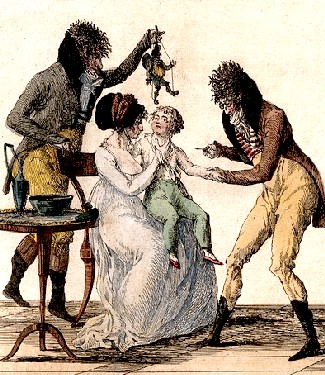
New World Quarantine Page Menu: 1 2 3 4 5 6 7 8 9 Next>>
New World Quarantine During the Golden Age of Piracy, Page 5
History of Small Pox, Continued
Smallpox In the Caribbean and North America
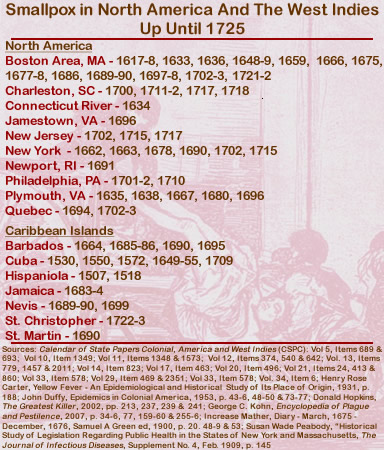
Artist: William Burgis, att
A North East View of the Great Town of Boston, (c. 1723)
Smallpox is first noted in the Caribbean in 1508 at Hispaniola (modern Haiti). However, it wasn't until the 17th century that it began to have a truly devastating effect, both in the European and Indian residents. As the chart seen at left shows, the seventeenth and early eighteenth centuries in the period under study were especially rife with smallpox epidemics, often thought to have been brought by ships coming from Africa.
A smallpox pandemic swept through Europe and the Near East in 1614 likely leading to what is often considered the first North American outbreak in English and French colonies which began in 1617.1 As a result, ninety percent of the native population succumbed on the Massachusetts coast. Like the natives in Central and South America, the Native North Americans were particularly vulnerable to the illness resulting in the deaths of a large number of them during this period.
An epidemic occurred near Plymouth in 1633, likewise decimating the native population there. This boosted the position of the struggling English colony, although twenty of their number succumbed as well. From here, the virus spread through the inland native population over the next few decades, creating havoc among them. "The Indians' complete susceptibility [to smallpox] made [its'] spread inevitable."3 Although there were only a small number of Plymouth settlers who succumbed during this epidemic, the fact that any of them did shows that even the English were not immune either.
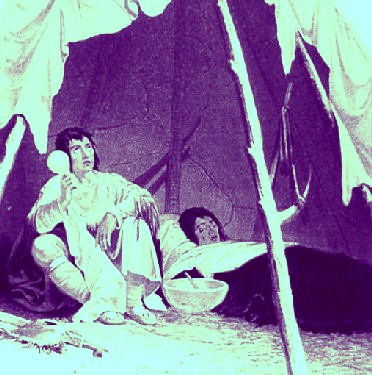
Artist: Captain Samuel Eastman
Native Being Treated for Smallpox, From History of the Indian Tribes of the
United States (1857)
A variety of instances of the illness are described taking place among the Europeans in various period documents. The remainder of this section focuses on those which occurred just before and during the golden age of piracy.
Massachusetts Bay-based Puritan clergyman Increase Mather mentioned several smallpox outbreaks in the Boston area in the late seventeenth century. In October of 1675, he said that smallpox had come to Boston "in ye harbor."4 In June of 1678, a public fast was declared due to another outbreak of the illness. By "The latter end of Aug & beg of Sept the small Pox spread much in Boston. This new Moon 150 Persons fell down by ye small pox. above 30 taken in a day."5
Historian John Duffy says that the second outbreak described by Mather grew out of one which started in the summer of 1677 in Charleston and became epidemic in the winter of that year.6 As late as February of 1679, Boston governor John Leverett advised English Secretary of State for the area Joseph Williamson that "The Lord's hand bath been stretched forth upon us in great mortality by fevers and the small-pox."7
In November, 1683, Jamaican governor Sir Thomas Lynch told the Lords of Trade and Plantation that the island was experiencing "great sickness, especially from small-pox at Port Royal, but more ships than ever yet were seen."8 Apparently the ships weren't concerned about the outbreak. It is interesting that Lynch doesn't mention any connection between the increased sea traffic and the cause of the illness. By the end of February, Lynch said that "small-pox has raged at Port Royal like the plague, but is now ceased."9
Barbados experienced an outbreak in 1685, which caused acting Governor Edwyn Stede to tell the Lords of Trade and Plantation in September that the island was suffering "a very sickly time of fevers and small-pox, of which
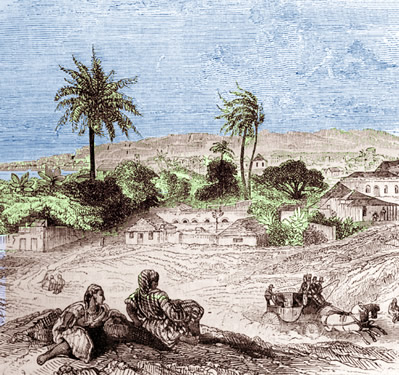
Bridgetown, Barbados, From Le Magasin Pittoresque, p 17 (1840)
great numbers have died."10 The next month he warned the Lords that "the people …are for the most part greatly in debt, and under great affliction by the loss of this year's crop, through ill weather, and by the mortality among negroes and servants through small-pox, which still continues very violent."11 The illness raged on Barbados until April, 1686 with Stede having to cancel his council meetings "from time to time, the members in the country being afraid to come to town"12. The militia were also unable to finish repair of Charles Fort "owing to the losses by small-pox, until that loss be made good by the supply of other men."13
A major smallpox epidemic began in Massachusetts in October of 1689 which was blamed on a shipment of infected slaves from the West Indies. This was to continue through for two years, infecting many of the colonies in New England. "[O]n July 10, Public Occurrences, America's first newspaper, declared that the epidemic was more widespread, but not so fast, as the previous one of twelve years earlier. The editor estimated the death toll to be about 320 and added that the infection, which raged most in June, July, and August, attacked 'all sorts of people,' even 'children in the bellies of their Mothers.'"14 Charles Lodwick, wrote a letter in which he said that in 1690 New York was infected with "ye Small Pox, which was very mortal, especially to grown people"15. Historian Duffy notes that smallpox continued on the northeastern coast of the continent through 1691, being helped along by the forces waging the War of the Grand Alliance (1688–1697).16 Rhode Island Governor John Easton had to decline to help the war effort because of the illness. "We have suffered much from smallpox also at Newport, which further disenables us to send men for Quebec, as we need them all for our own defence."17
The transportation of the troops was likely at least partially responsible for the widespread movement of the virus. Acting Barbadian Governor Stede reported in 1690 that he had heard that
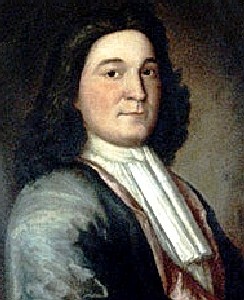
Artist: Thomas Child
Massachusetts Bay Governor William Phips (c. 1687-94)
"only two hundred of Sir T[imothy]. Thornhill's men are left [after attacking St. Martin], whereas there is only that number lost by unusual mortality through smallpox and fevers, which no man could have prevented. The French have suffered much from the same cause"18. The French reportedly also suffered at Quebec during the war. In January of 1694, Massachusetts Bay Governor William Phips said, "The Indians also informed me that small-pox is very sore at Quebec, sweeping off many of the inhabitants and Indians, which seems encouraging for an attack in the spring"19. A letter written in August, 1695 found concerning Barbados states, "The towns are full of small-pox, and few companies returned without loss of several men, while the small-pox spreads throughout the Island."20
Of course, not all smallpox instances during this period are directly linked to the war, although, they could have resulted from or been exacerbated by English troop movements. Captain-general of the English Leeward Islands Christopher Codrington mentioned in a March, 1690 missive to the Council of Trade and Plantations that "in Nevis they have lost since the beginning of last August over six hundred white men, with women and children in proportion, besides slaves; and although they are now pretty clear of smallpox, the fever is still among them."21 The minutes of the April 28, 1696 General Assembly of Virginia note that the assemblies had been postponed for a long period "owing to the prevalence of small-pox."22
The years 1702 and 1703 saw another large outbreak of the illness in the North American colonies. It swept through Pennsylvania, Boston, New Jersey, New York and Canada. Puritan minister Cotton Mather mentioned on July 4, 1702 that smallpox had begun to spread in Boston.23 Writing in December of 1702,
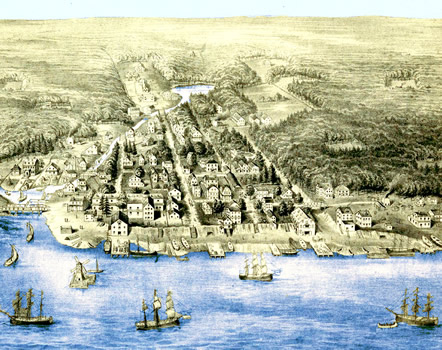
Artist: Frederick Wade - Philadelphia and Harbor in 1702, (1875)
Pennsylvania Lieutenant-Governor Andrew Hamiton said "The small-pox has run thro' [Pennsylvania] and West Jersey... but ... [it] carried off but few. Poor New York lies under a sorer affliction, for after the small-pox had run over the town, a malignant fever ensued, wch. has carried off several hundreds"24. He went on to say that communications with New York had broken off since many of those who survived had left for the 'Jerseys' and Long Island. He also mentions that the winter weather basically put an end to the smallpox epidemic in Pennsylvania in 1702.
Yet, in March of 1703, the Council of Massachusetts Bay warned that since smallpox 'lately been spread through the town', those members coming to the General Court or Assembly in Boston were "forthwith to cleanse and aire their houses, and to burn some tarr therein to prevent infection" from spreading because some of the other members "probably may not have had the small-pox"25. New York Governor Edward Hyde in June, 1703 wrote that he had heard from spies "that there has been a very great mortality against the people of Canada occasioned by the small-pox, which has carryed off some hundreds of people"26. Historian John Duffy says as much as a quarter of the population there may have died during this epidemic.27
Smallpox descended on Charleston, South Carolina in 1711. Gideon Johnston, the local representative of the the Society for the Propagation of the Gospel for the city, wrote on November 16, 1711, "Never was there a more sickly or fatall season than this for the small Pox, Pestilential ffevers, Pleurisies, and fflux's have destroyed great numbers here of all sorts, both whites Blacks and Indians,

Hospital Sickroom, From Haus-Feld-Koch-Kunst-etc Buch (1682)
and these distempers still rage to an uncommon degree"28. Because his account includes so many different illnesses among those present in this 'sickly seasons', it is not clear just how much of the resulting sickness and death were caused by smallpox. In March of 1712, the Boston News-letter focused on smallpox and pestilential fevers as the cause of 'many deaths' at Charleston, noting that the epidemics were coming to an end.29
April of 1721 saw a major epidemic of smallpox in Boston. Doctor William Douglas wrote to Cadwallader Colden that Boston had received "from Barba[dos] the small Pox midle of April 1721, and by Jan. following it was near over having affected only Boston and two or three adjacent Towns"30. Cotton Mather recorded in his diary on May 26th of that year, "The grievous Calamity of the Small-Pox has now entered the Town."31 Douglas goes on to explain that the epidemic started slowly, with the city officials quarantining the houses where the illness was present until the middle of June. He later states that by February of 1722, "it was found that Boston consisted of 10.565 souls, whereof about 6.000 have now had the small Pox and of these 844 dy[e]d; about 700 who never had it, escaped, and a few who remain'd in the Country in fear"32.
The reader will note that there were a variety of other instances of smallpox outbreak, although little contemporary information was found for them. This makes it unclear whether these were actual outbreaks of the illness, although because smallpox was so well recognized, it is unlikely that it would have been misidentified.
1 Frank Fenner, Donald A. Henderson, Isao Arita, Zdenek Jezek & Ivan D. Ladnyi, Smallpox and its Eradication, 1988, p. 238; 2 Donald Hopkins, The Greatest Killer, 2002, p. 234; 3 Hopkins, p. 235; 4 Increase Mather, Diary - March, 1675 - December, 1676, Samuel A Green ed, 1900, p. 20; 5 Mather, p. 49; 6 John Duffy, Epidemics in Colonial America, 1953, p. 46; 7 Calendar of State Papers Colonial, America and West Indies (CSPS): Volume 10, 1677-1680, Item 878; 8 CSPS, Volume 11, Item 1348; 9 Ibid, Item 1563; 10 CSPS, Volume 12, Item 374; 11 Ibid, Item 419; 11 Ibid, Item 540; 13 Ibid, Item 642; 14 Duffy, p. 48; 15 Charles Lodwick, "New York in 1692. Letter from Charles Lodwick… May 20, 1692", Collections of the New York Historical Society, Second Series, Vol. II, 1848, p. 248; 16 Duffy, p. 72; 17 CSPS: Vol. 13, Item 1457; 18 Ibid, Item 779; 19 CSPS: Vol. 14, Item 823; 18 Ibid, Item 2011; 21 CSPS: Vol. 13, Item 789; 22 CSPS: Vol. 14, Item 2351; 23 Cotton Mather, The Diary of Cotton Mather 1681-1708, 1911, p. 435; 24 CSPS: Vol. 21, Item 23; 25 Ibid, Item 413; 26 Ibid, Item 860; 27 Duffy, p. 50; 28, 29 Cited in Duffy, p. 75; 30 The New-York Historical Society, The Letters and Papers of Cadwallader Colden, Vol. 1, 1711-29, p. 141; 31 Cotton Mather, The Diary of Cotton Mather 1709-1724, 1912, p. 620; 32 New-York Historical Society, p. 143
Variolation in the New World

Artist: Circle of Charles Jervais - Martin Lister (late 17th - early 18th c.)
The history of smallpox during the golden age of piracy can hardly be discussed without mentioning variolation, the first form of inoculation. Although its origins may have been ancient, official English awareness of the practice came via a letter written by East India Company trader Joseph Lister to Dr. Martin Lister of the Royal Society in January of 1700. In it, Lister described how the Chinese he had encountered in Amoy inoculated people by blowing the dust of powdered smallpox scabs up a patient's nose, giving them a mild case of the illness and making them less likely to die from the illness.
In December of 1713, Italian physician Emmanuel Timoni wrote a description of the process which Dr. John Woodward read to the Royal Society in May of 1714. A summary of this was published by the Society explaining the process:
...the Matter of the Pustules is to be communicated to the Person proposed to take the Infection; whence it has, metaphorically, the name of Incision or Inoculation. For this purpose they make choice of some Boy, or young Lad, of a sound healthy Temperament, that is seized with the common Small-pox (of the distinct, not Flux sort,) on the twelfth or thirteenth day from the beginning of his Sickness; they with a Needle prick the Tubercles (chiefly those on the Shins and
"La Vaccine," Caricature From Depuille Series on Vaccination (c. 1800)
Hams) and press out the Matter coming from them into some convenient Vessel or Glass, or the like, to receive it; it is convenient to wash and clean the Vessel first with warm Water: A convenient quantity of this Matter being thus collected, is to be stop'd close, and kept warm in the Bosom of the Person that carries it, and, as soon as may be, brought to the place of the expecting future Patient.The Patient therefore being in a warm Chamber, the Operator is to make several little Wounds with a Needle, in one, two of more places of the Skin, till some drops of Blood follow, and immediately drop out some drops of the Matter in the Glass, and mix it well with the Blood issuing out one drop of the Matter is sufficient for each place prick'd. These Punctures are made indifferently in any of the fleshy Parts, but succeed best in the Muscles of the Arm or Radius. The Needle is to be a three-edg'd Surgeon's Needle; it may likewise be perform'd with a Lancet: The
custom is to run the Needle transverse, and rip up the Skin a little, that there may be a convenient dividing of the Part, and the mixing of the Matter with the Blood more easily perform'd; which is done, either with a blunt Stile, or an Ear-picker: The Wound is cover'd with half a Walnut-shell, or the like Concave Vessel, and bound over, that the Matter be not rub'd off by the Garments, which is all removed in a few Hours. The Patient is to take care of his Diet. In this place the Custom is to abstain wholly from Flesh and Broath for 20 or 25 days.1
Other reports were received by the society about the practice, although they resisted using the process.2
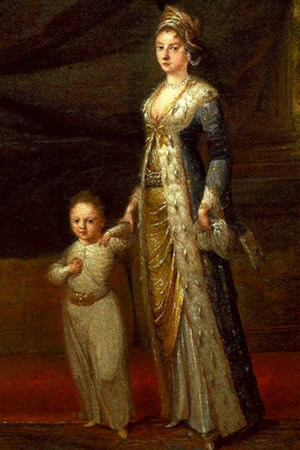
Artist: Jean Baptiste Vanmour
Lady Mary Wortley Montagu and Son Edward (c. 1717)
It was the wife of the British ambassador to Turkey who actually brought the procedure to the fore in English Medicine. Lady Mary Montagu and brother had caught smallpox when she was twenty-six. Her twenty year old brother died of the illness and, although she survived, her face was covered with smallpox scars. "Fearing a smallpox attack on her six-year-old son, she had him variolated during her husband’s absence from Constantinople, presumably because he objected to the procedure."3 Dr. Timoni oversaw the procedure as performed by Scottish surgeon Charles Maitland in March of 1718, which was successful.
Maitland next variolated six condemned prisoners at Newgate Prison in August of that year on the condition that if they survived the process, they would be set free. "Witnessed by over twenty-five members of the Royal Society and reported publicly by newspapers, variolation showed a dramatic protective effect."4 Around this time, Lady Montagu told her friend the Princess of Wales about the procedure performed on her son. Having also heard of it from physician Hans Sloane, the princess had her daughters variolated in in 1722. "These royal inoculations began the firm establishment of inoculation as acceptable medical practice in England. The new practice was not widely accepted immediately, however. Fewer than nine hundred persons were inoculated in England and Scotland in the first eight years after inoculation was introduced."5
In the New World, preacher Cotton Mather of Boston was one of the most vocal proponents of variolation. Mather wrote a letter to physician John Woodward of the Royal Society on July 16, 1716 in which he explains how he first learned of the process:
I had from a Servant of my own, an Account of its being practised in Africa. Enquiring of my Negro-man Onesimus, who is a pretty Intelligent Fellow, Whether he ever had ye Small-Pox; he answered, both, Yes, and, No; and then told me, that he had undergone an Operation, which had given him something of ye Small-Pox, & would forever preserve him from it; adding, That it was often used among ye Guramantese [the Garamantes of modern Libya], & whoever had ye Courage to use it, was forever free from ye fear of the Contagion. He described ye Operation to me, and shew'd me in his Arm ye Scar, which it had left upon him; and his Description of it6

Artist: Peter Pelham - Cotton Mather (c. 1700)
Mather references the procedure to Emmanuel Timoni's description. He then asked why the practice isn't more popular in England and states "if I should live to see ye Small-Pox again enter into o[u]r City, I would immediately procure a Consult of or Physicians, to Introduce a Practice, which may be of so very happy a Tendency."7
In fact, when the 1721 Boston epidemic took hold, Mather reiterated this point in his diary: "The Practice of conveying and suffering the Small-pox by Inoculation, has never been used in America, nor indeed in our Nation. But how many Lives might be saved by it, if it were practised? I will procure a Consult of our Physicians, and lay the matter before them."8 On June 6 Mather wrote an Address to the Physicians of Boston, a summary of two letters presented to the Royal Society - the one by Timoni and another by fellow Jacob Pylarini Mather - and sent it to the physicians.9
Physician Zabdeil Boylston agreed to try the procedure and on June 26th, "used a 'sharp toothpick and quill' to inoculate his only son Thomas (age six), and two Negro slaves with pus from a smallpox patient... All three developed favorable mild infections, which made them immune."10 Note everyone agreed with his experiment. The Boston physicians and citizens were outraged that Boylston had willingly infected people with the smallpox virus. Dr. William Douglass wrote a variety of letters to the New England Courant condemning inoculation. This led to a very public disagreement between Mather and Douglass which medical historian Donald Hopkins says was a both a clash of personalities and "a struggle over the larger issue of institutional 'prestige and authority,' that is, the extent to which the Puritan ministers should continue to dominate virtually all aspects of the community's secular and religious life."11
Boylston went on to inoculate two-hundred and forty four people in the Boston area in 1721-2 while two other doctors inoculated 36 people in Cambridge and Roxbury. Of Boylston's two-hundred and forty four inoculated patients, only six of them died.12 However, as the numbers indicate, the impact of variolation during this period in both England and the New World was minimal and its use amongst sailors would have been nearly, if not entirely, nonexistent.
1 "An Account, or History, of the Procuring the Small Pox by Incision or Inoculation", Philosophical Transactions of the Royal Society, 31 December 1714, p. 73-4; 2 Donald Hopkins, The Greatest Killer, 2002, p. 46-7; 3 Michael B. A. Oldstone, Viruses, Plagues, and History, 2000, p. 36; 4 Hopkins, p. 48; 5 Hopkins, p. 49; 6,7 "Curiosities of the Small Pox", cited in George Lyman Kettredge, Some Lost Works of Cotton Mather, 1912, p. 422; 8 Cotton Mather, The Diary of Cotton Mather 1709-1724, 1912, p. 620-1; 9 Kittredge, p. 428; 10 Hopkins, p. 249; 11 Hopkins, p. 250; 12 Hopkins, p. 253
Golden Age of Piracy Sailors and Smallpox
“Usually it [smallpox] arrived by ship with settlers from Europe, or with slaves from the West Indies or Africa. This pattern of importation was evident from the earliest days of the colonies.” (Donald Hopkins, The Greatest Killer, 2002, p. 237)
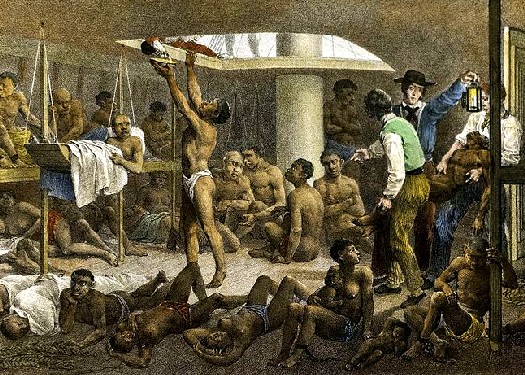
Artist: Johann Moritz Rugendas - Hold of a Slave Ship, Navio negreiro (1830)
For smallpox to take hold in a community, it needed a group of individuals who hadn't already survived the illness and ships were one way such a group could be introduced. (The other primary method was through new births in the community which is why the disease eventually became an illness associated with children.) Many ships coming to the new world arrived via the triangle trade route, sailing down the coast of Europe and northern Africa, sailing across the Atlantic to the Caribbean and then up to New England. Merchant, slave and naval ships all traveled this route during the golden age of piracy. Africa was rife with the smallpox virus and slaves were a convenient vehicle for its transportation. Slaver captain Thomas Philips wrote in 1694, "The negroes are so incident to the small-pox, that few ships that carry them escape without it, and sometimes it makes vast havock and destruction among them: but tho’ we had 100 at a time sick of it, and that it went thro’ the ship, yet we lost not above a dozen by it."1
On March 20, 1664, Jamaican Governor Thomas Modyford and Barbados Council member Peter Colleton wrote to the
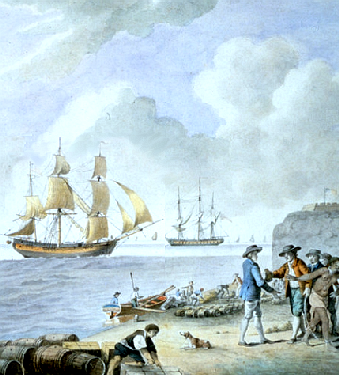
Artist: Samuel Hutchinson - "Slave Traffic" (1793)
Royal African Company (which held the monopoly on trade with Africa during much of the golden age of piracy) that
The Speedwell arrived [at Barbados] with 282 negroes, who have greatly lost in value owing to small-pox breaking out among them. The Success brought 193 blacks, and these, with Capt. Norbrook's, have produced the best of any. The Susan brought 230 negroes, which were not allowed to be discharged until the officers of the ship had proved they had not been within the Company's limits. Duke has been furnished with 30l. and the doctor with 9l. 13s., for inspecting the negroes at 12d. per head.3
Similar inspections were established in Central America and the Caribbean in the seventeenth and eighteenth centuries to prevent slave ships from bringing Africans ashore until they were proven healthy as we shall see in the section on quarantine.
Eleven days after the arrival of these slave ships, Modyford and Colleton wrote the Company to tell them that they planned to ship 300 slaves to Nevis and St. Christopher because no one wanted to buy them at Barbados. The Africans had contracted another illness which, coupled with the smallpox outbreak on the Speedwell, made them undesirable to the planters on Barbados. Captain James Carteret then sailed the Speedwell to St. Christopher where he sold them.4
The fact that sea surgeon John Moyle thought fit to include a chapter on treating smallpox in his book The Sea Chirugeon attests to the problem smallpox could pose while at sea. In introducing his topic, Moyle states "It many times happens that Men, (especially the younger sort) have these Diseases in a Ship."5 There are a variety of land-based accounts of ships arriving in port with sailors and passengers suffering from smallpox as suggested in the history of the illness. In a letter written by Boston merchant James Lloyd, he talks about what he felt
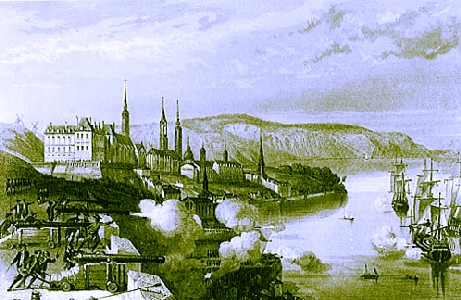
Artist: Charles Van Tenac
La défense de Québec en 1690 par Frontenac durant la guerre de la Ligue d'Augsbourg (1847)
was a poorly prepared private expedition of 32 ships sent to Quebec near the beginning of the War of the League of Augsburg in January of 1691.
The first ship that arrived had lost 65 out of 120 men by small-pox and fever; others had lost considerably, and now on the 8th of January there are still eight vessels missing, while three more have been cast away and burnt. Small-pox and fever were rife among them; and the men still die like rotten sheep, infecting the country, so that we fear within a twelvemonth that a quarter of them will be dead. This expedition is very costly and the burden falls on Massachusetts.6
Another account from the Council of Massachusetts from December of 1702 mentions that "6l. 11s. 10d. paid for doctor's attendance etc. upon 4 seamen belonging to H.M.S. Province galley, put on shore sick of the small-pox."7
Similarly, a number of temporary quarantine orders were issued by city or town officers against certain ships with infected passengers or slaves. Like the previous two accounts, they often mention the ships bringing infected passengers or crew. While such accounts do indicate smallpox being present on the ships discussed, they usually give little detail about the situation ship-board. Rather than include them here as lists of quarantined ships, such accounts will be discussed in the section on quarantine procedures in the New World where they are more appropriate. The remainder of this section focuses instead on one period sailor's detailed account of his bout with smallpox along with two pirate-related accounts - one telling of a young man who contracted the illness after escaping from Edward Low's crew and the other concerning a group of pirates who used the presence of the virus to their advantage.
While employed on a half-decked merchant sloop on the Virginia coast
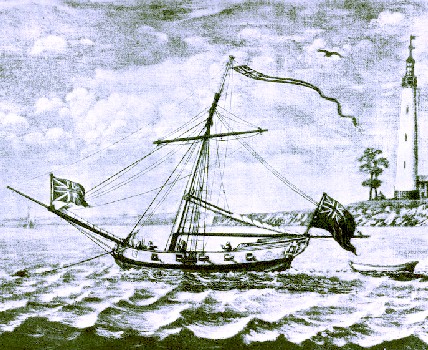
Artist: William Burgess
An Armed Merchant Sloop Near the Boston Lighthouse (c. 1715-50)
in the fall of 1698 in the beginning of his career, sailor Nathaniel Uring boarded a ship that contained several people ill with smallpox, a virus he admitted he had never had. "I ventured on board the Ship, believing what I had been told, that those who were not afraid of that Distemper wou'd not be infected with it; I therefore went carelesly to and fro in the Ship, without any Apprehension of Danger, but it was not long before I paid dearly for that Heedlessness."8 He contracted the illness which affected him so intensely he and others in the crew feared he would die from it. "I continued extremely sick, and grew delirious...I continued in that Condition several Days, when the Small-Pox appeared all over me: The Master of the Sloop perceiving my Distemper, and having some Saffron on board, infused some of it in warm Rum Punch, and gave me to drink, by which I found great Benefit"9.
His condition improved, although he complained that the ship was cold, probably as a result of the fever that accompanies smallpox. He explains
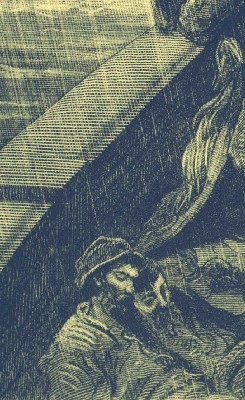
Artist: Gustav Dore
"And the Rain Poured Down...", From Rime of the
Ancient Mariner (1876)
the Sloop having only a Half Deck over the Forecastle, and not a Bulk Head [wall creating a separate area below deck] in her, I had but cold Lodging. I placed my Bed close to the Side of the Fire Hearth to keep my self as warm as possible, a Blanket and a Piece of old Sail all my Covering, except my Wearing Apparel, which were few enough; the Deck of the Sloop over the Place where I lay, wanted caulking; so that the Snow and Rain which fell came through the Seams, with which I was continually wet. When I found the Wet come through to my Skin, by continually dropping in one Place, I moved the Covering, and received it in another Part, till at last my Covering was wet all over, and a little Puddle of Water settled under the lower Part of my Back.10
He was lucky the ship was at anchor or they would probably not even have had a fire. He later explains that the "Weather continued cold and rainy for several Days; my wet Cloaths made me very uneasy"11.
Six days later, the sloop reached shore along the Rappahannock River in Virginia where a woman who learned of his sickness "was so good as to send me some Rum, a little Saffron, and a Couple of Fowls for my Refreshment, but would by no Means allow me to go to her House for fear of infecting her Family. I was very much dejected when I found I was obliged to remain on Board in so sad a Condition."12 Fresh fowl is mentioned as being more appropriate than salt pork or beef for sailors recovering from other illnesses by sea surgeons.
The owner of the goods being shipped on the sloop came aboard before they landed. Worried at how the farmers would react upon learning one of the crew had smallpox, the owner arranged to have Uring put ashore and lodged in an out building owned by a local planter before the ship docked.
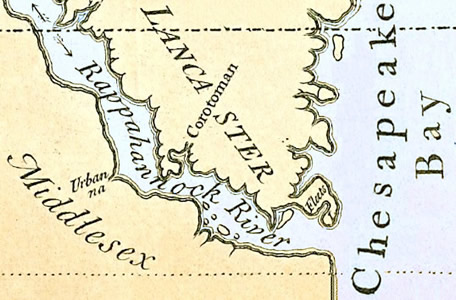
From Map of Rappahannock River, Showing Carrotoman River in Virginia (1740)
Although quite ill, Uring was happy to learn he could leave the cold ship. "[W]ith the help of the Seamen [I] put on my wet Cloaths;but when we landed I found my self so very weak, that I could hardly stand. We were at least a Mile distant from the House I was to go to; I attempted to walk, but being very weak and faint, could not without the Help of the Seamen, who supported me under each Arm."13 The sailors decided it would be easier to carry him, but that was painful for him and difficult for them, so he went back to walking with their help.
"[A]t last, with great Trouble and Pain, I came to the Room designed for me, almost dead; but being put into a warm Bed, I soon revived. After I had rested and recovered my self a little in Bed, the Servant brought me some Supper, on which I fed very heartily, and then fell asleep, and in the Morning found my self very hungry"14. He remained in the out building for about two weeks, being fed breakfast in the morning and dinner in the early afternoon. At the end of that period, he was well enough to leave.
Nicholas Merritt gave an account of contracting the small pox shortly
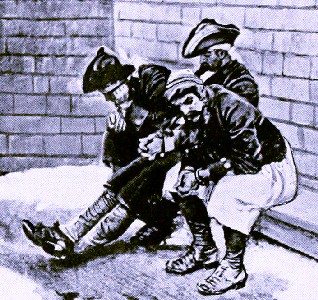
Artist: Howard Pylr
The Pirates' Christmas (1893)
after escaping from Edward Low's crew and making his way to São Miguel in the Azores in 1722. Merritt came down with the 'dreaded' distemper while spending four months in jail. "To be seiz’d with it in a
Prison, where I had no Help, no Physician, nor any Provision suitable thereto; only upon my first being taken I sent word of it to the Consul, who was so kind as to send some Bundles of Straw for me to lie upon... and the Portugueze gave me some Brandy, and Wine & Water to drive out the Pock."15 This appears to have been what physician Thomas Sydenham called the 'distinct' smallpox. Merritt explains that "the Pock came out well, and fill’d kindly, and then I had the Comfort of seeing some of the Portugueze look more Pleasant, and hearing them say, in their Language, that it was the good sort."16 Merritt still got quite sick five or six days after the pocks appeared, but he survived.
Pointing more directly to the presence of smallpox aboard a pirate vessel, it was mentioned at a trial of some of Edward Low's men that Benjamin Weekham, "having the Small Pox was by John Waters one of the Prisoners at the Bar carried on board another Vessel"17.
The last account is of the ketch-rigged vessel
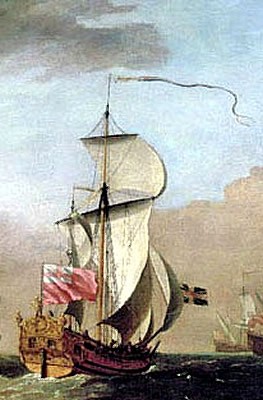
Artist: Willem van de Velde the Younger
Christopher Monck's Ketch (17th c.)
Elinor, captained by William Shortriggs, who had anchored her near the mouth of Boston Harbor on November 20th, 1689. "She was inward bound from the island of Nevis, loaded with sugar and indigo, and the wind failing and the flood tide being almost spent, the captain was obliged to anchor as most of his men were sick or disabled with the cold."18 Vessel owner Thomas Cooper tried to get a permit to bring the ketch into port, but was unable because there had been smallpox aboard. Cooper was told he could bring the craft into the harbor as far as Castle Island, which was used at that time for quarantine. Some men were sent to the harbor with this information. "The next morning (November 23rd) they returned and astonished the captain with the news that the ketch had disappeared from her anchorage."19
She was not there because the seven sailors and passengers aboard the ketch had been taken on November 21st by pirates William Coward, Pegleg Heath, Thomas Storey and Christopher Knight. "[W]ith Swords and Guns as Pirates and Felons [they] did Enter [the vessel]. And... [took] all her appur[ten]ces. together with several Cloth's of the Masters and Seamen And severall goods and money ...to the value of Two hundred pounds ...from the said Seamen and passengers"20. The pirates then sailed the Elinor to Cape Cod where they agreed to purchase "a gallon of rum, some biscuits and some cheese" from a shallop. The men aboard the shallop told them that they would have to bring the ketch closer to shore to get their goods. So they brought her ashore at midnight 'and disappeared'.21
They were later caught, jailed and indited in court in January of 1690, but were eventually reprieved on a technicality. Coward protested the justness of the trial because it had occurred in the interregnum between outgoing Virginia Governor Edmund Andros and incoming Governor William Phips. This meant that Andros, who would have been in charge of the Vice Admiralty Court, was not the Vice Admiral when the trial occurred.22
1 Thomas Phillips, A Journal of a Voyage Made in the Hannibal, 1694, Churchill, p. 237; 2 Calendar of State Papers Colonial, America and West Indies [CSPS]: Volume 5, 1661-1668, Item 689; 3 Ibid, Item 693; 4 Doug Ford, "A Respectable Trade or Against Human Dignity", The Heritage Magazine, 2006, p. 6; 5 John Moyle, Abstractum Chirurgæ Marinæ, 1686, p. 123-6; 6 CSPS, Vol. 14, 1693-1696, Item 1282; 7 CSPS, Volume 21, 1702-3, Item 93; 8 Nathaniel Uring, A history of the voyages and travels of Capt. Nathaniel Uring, 1928, p. 8; 8,9,10 Uring, p. 9; 11 Uring, p. 10; 12 Uring, p. 9-10; 13,14 Uring, p. 10; 15 Nicholas Merritt, “A Short Account of Mr Nicholas Merritt’s Escape from Pirates,” from Ashton’s Memorial Strange Adventures and Signal Deliverance, 1726, p. 97-8; 16 Merritt, p. 98-9; 17 “Tryals of Thirty Six Persons for PIRACY", 1723, British Piracy in the Golden Age, Volume 3, 2007, p. 180; 18,19 George Francis Dow and John Henry Edmonds, The Pirates of the New England Coast 1630-1730, 1996, p. 32; 20 Massachusetts, Records of the Court of Assistants of the Colony of Massachusetts Bay, 1630-1692, Vol1, 1901, p. 319; 21 Dow and Edmonds, p. 33; 22 "52. William Coward's Plea, 1690", Privateering and Piracy in the Colonial Period - Illustrative Documents, John Franklin Jameson, ed., 1923, p. 145

